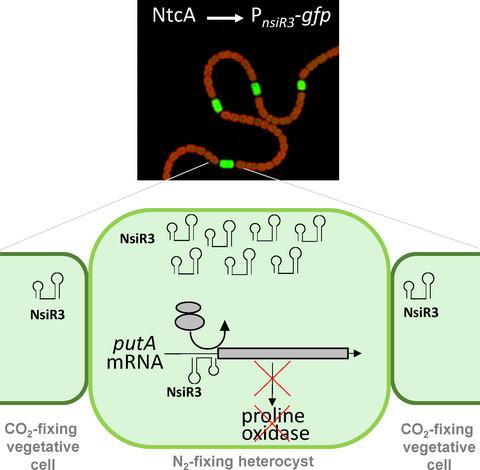Our official English website, www.x-mol.net, welcomes your feedback! (Note: you will need to create a separate account there.)
NsiR3, a nitrogen stress‐inducible small RNA, regulates proline oxidase expression in the cyanobacterium Nostoc sp. PCC 7120
The FEBS Journal ( IF 5.4 ) Pub Date : 2020-08-15 , DOI: 10.1111/febs.15516 Isidro Álvarez-Escribano 1 , Manuel Brenes-Álvarez 1 , Elvira Olmedo-Verd 1 , Jens Georg 2 , Wolfgang R Hess 2 , Agustín Vioque 1 , Alicia M Muro-Pastor 1
The FEBS Journal ( IF 5.4 ) Pub Date : 2020-08-15 , DOI: 10.1111/febs.15516 Isidro Álvarez-Escribano 1 , Manuel Brenes-Álvarez 1 , Elvira Olmedo-Verd 1 , Jens Georg 2 , Wolfgang R Hess 2 , Agustín Vioque 1 , Alicia M Muro-Pastor 1
Affiliation

|
NsiR3 (nitrogen stress‐inducible RNA 3) is a small noncoding RNA strongly conserved in heterocyst‐forming cyanobacteria. In Nostoc sp. PCC 7120, transcription of NsiR3 is induced by nitrogen starvation and depends on the global nitrogen regulator NtcA. A conserved NtcA‐binding site is centered around position −42.5 with respect to the transcription start site of NsiR3 homologs, and NtcA binds in vitro to a DNA fragment containing this sequence. In the absence of combined nitrogen, NsiR3 expression is induced in all cells along the Nostoc filament but much more strongly in heterocysts, differentiated cells devoted to nitrogen fixation. Co‐expression analysis of transcriptomic data obtained from microarrays hybridized with RNA obtained from Nostoc wild‐type or mutant strains grown in the presence of ammonium or in the absence of combined nitrogen revealed that the expression profile of gene putA (proline oxidase) correlates negatively with that of NsiR3. Using a heterologous system in Escherichia coli, we show that NsiR3 binds to the 5′‐UTR of putA mRNA, resulting in reduced expression of a reporter gene. Overexpression of NsiR3 in Nostoc resulted in strong reduction of putA mRNA accumulation, further supporting the negative regulation of putA by NsiR3. The higher expression of NsiR3 in heterocysts versus vegetative cells of the N2‐fixing filament could contribute to the previously described absence of putA mRNA and of the catabolic pathway to produce glutamate from arginine via proline specifically in heterocysts. Post‐transcriptional regulation by NsiR3 represents an indirect NtcA‐operated regulatory mechanism of putA expression.
中文翻译:

NsiR3是一种氮胁迫诱导的小RNA,调节蓝细菌Nostoc sp。中脯氨酸氧化酶的表达。PCC 7120
NsiR3(氮胁迫诱导性RNA 3)是一种小的非编码RNA,在形成异囊藻的蓝细菌中强烈保守。在Nostoc sp。PCC 7120中,NsiR3的转录是由氮饥饿引起的,并且取决于全局氮调节剂NtcA。相对于NsiR3同源物的转录起始位点,保守的NtcA结合位点在-42.5位置上居中,并且NtcA在体外与包含该序列的DNA片段结合。在没有结合氮的情况下,沿着Nostoc细丝的所有细胞均会诱导NsiR3表达,而在异种囊(分化为氮固着的分化细胞)中会更强烈地诱导这种表达。从与Nostoc获得的RNA杂交的微阵列获得的转录组数据的共表达分析在铵存在或不存在氮的情况下生长的野生型或突变菌株表明,putA(脯氨酸氧化酶)基因的表达谱与NsiR3负相关。使用大肠杆菌中的异源系统,我们显示NsiR3与putA mRNA的5'-UTR结合,从而导致报告基因的表达降低。NsiR3在表达发菜导致强烈减少PUTA mRNA的积累,进一步支持的负调控PUTA通过NsiR3。NsiR3在N 2的营养细胞中比在胚泡中更高的表达固定丝可能会导致先前描述的putA mRNA和分解代谢途径的缺失,而后者通过精氨酸在精巢中特异地从精氨酸中产生谷氨酸。NsiR3的转录后调控代表putA表达的NtcA间接调控机制。
更新日期:2020-08-15
中文翻译:

NsiR3是一种氮胁迫诱导的小RNA,调节蓝细菌Nostoc sp。中脯氨酸氧化酶的表达。PCC 7120
NsiR3(氮胁迫诱导性RNA 3)是一种小的非编码RNA,在形成异囊藻的蓝细菌中强烈保守。在Nostoc sp。PCC 7120中,NsiR3的转录是由氮饥饿引起的,并且取决于全局氮调节剂NtcA。相对于NsiR3同源物的转录起始位点,保守的NtcA结合位点在-42.5位置上居中,并且NtcA在体外与包含该序列的DNA片段结合。在没有结合氮的情况下,沿着Nostoc细丝的所有细胞均会诱导NsiR3表达,而在异种囊(分化为氮固着的分化细胞)中会更强烈地诱导这种表达。从与Nostoc获得的RNA杂交的微阵列获得的转录组数据的共表达分析在铵存在或不存在氮的情况下生长的野生型或突变菌株表明,putA(脯氨酸氧化酶)基因的表达谱与NsiR3负相关。使用大肠杆菌中的异源系统,我们显示NsiR3与putA mRNA的5'-UTR结合,从而导致报告基因的表达降低。NsiR3在表达发菜导致强烈减少PUTA mRNA的积累,进一步支持的负调控PUTA通过NsiR3。NsiR3在N 2的营养细胞中比在胚泡中更高的表达固定丝可能会导致先前描述的putA mRNA和分解代谢途径的缺失,而后者通过精氨酸在精巢中特异地从精氨酸中产生谷氨酸。NsiR3的转录后调控代表putA表达的NtcA间接调控机制。


























 京公网安备 11010802027423号
京公网安备 11010802027423号